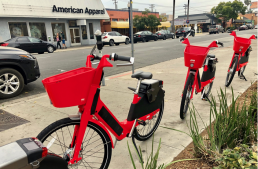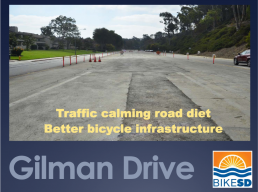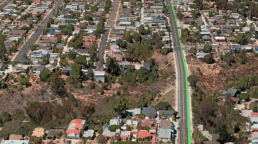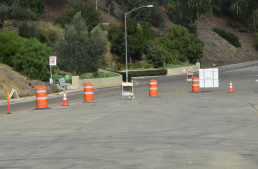Free JUMP ebike rides through December 9
 On November 19, 2018, Uber announced the launch of dockless electric bikeshare service JUMP in San Diego. JUMP bikes are electric and provide a boost with every pedal (up to 20 mph), making it easier for riders to get around their city without breaking a sweat.
On November 19, 2018, Uber announced the launch of dockless electric bikeshare service JUMP in San Diego. JUMP bikes are electric and provide a boost with every pedal (up to 20 mph), making it easier for riders to get around their city without breaking a sweat.
If you've been wanting to see what it feels like to ride an ebike, this is a great opportunity to check them out at no cost. Uber is giving everyone five free trips up to 30 minutes long each day through December 9. Unlock them using the Uber app by tapping the “mode switch” at the top of the Uber homescreen, select a bike, and the app will give you a pin number so you can unlock your bike. The JUMP Bikes app works pretty much the same way.
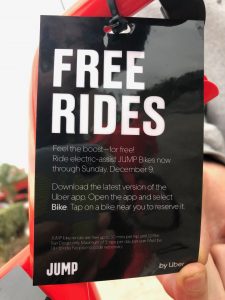 While pricing varies by city, in San Diego at launch, ebikes will cost $1 to unlock and then just 10 cents per minute to ride. JUMP will start with 300 bikes available across a 28 square mile radius, from Pacific Beach all the way downtown to Crim avenue; and from the northmost point at Chalcedony St. to the southmost point at National Ave.
While pricing varies by city, in San Diego at launch, ebikes will cost $1 to unlock and then just 10 cents per minute to ride. JUMP will start with 300 bikes available across a 28 square mile radius, from Pacific Beach all the way downtown to Crim avenue; and from the northmost point at Chalcedony St. to the southmost point at National Ave.
In 2017, JUMP bikes launched the first ever dockless electric bike share system in the United States. JUMP’s pedal assist bikes are available in Austin, Chicago, Denver, New York City, Providence, Sacramento, Santa Cruz, San Francisco, Santa Monica, Los Angeles, and Washington, D.C. They also have scooters available in Austin, Santa Monica and LA.
In California, JUMP is already bringing multimodal transportation to users across the state. In October, JUMP started expanding its fleet of bikes San Francisco, from 250 to 500 bikes after data showed that over 38,000 unique riders took more than 326,000 total trips during the pilot. Around Sacramento, JUMP recently expanded its service area by more than 50 percent to meet demand of more residents. And last week, it announced that it started deploying 3,000 ebikes and scooters across LA.
BikeSD is happy to see expanded options for bikeshare in San Diego. However, the continued shortage of safe, high-quality bike lanes across San Diego remains a substantial hindrance for riders of all kinds of low- and human-powered vehicles. We hope companies like Uber and JUMP will become partners with BikeSD to expand our advocacy and educational efforts. Without significant biking/mid-speed infrastructure improvements in San Diego, the adoption rate and potential of these new transport modes will always be limited.
Is it time to ditch the phrase "Road Diet"?
A four-lane road, Gilman Drive in La Jolla near the Univ. of California San Diego (UCSD), recently had new sewer lines installed. A stretch of this newly-repaved road was three weeks away from getting re-striped when BikeSD mobilized to have the speed limit reduced and buffered bike lanes added.
BikeSD had tentative support for this change of striping from staff at UCSD. But after BikeSD's executive director presented plans for a road diet to the local community advisory group, UCSD was upset. They felt BikeSD had pulled a fast one on them by switching from a “re-striping” to a “road diet.” They weren't sure they could or would support a "road diet" on Gilman Drive.
UCSD's reaction isn't surprising to road safety advocates. Very often, when average people — car drivers — hear the phrase "road diet," they have negative reactions. The word "diet" means reducing and restricting. A traditional diet may reduce carbs; a road diet reduces cars. A traditional diet may squeeze down your waistline; a road diet squeezes the room around your car.
While notions like reducing cars and squeezing the roadway appeal to bike and safety advocates, these phrases have no positive connotation to people on a community boards, traffic engineers, or average folks who depend on driving. Simply put: when advocates use the phrase "road diet" we conjure up the wrong imagery in the ears of our listeners.
On top of that, everyone knows: "Diets don't work."
So maybe it's time to ditch the phrase "road diet." And time to ditch the phrase "traffic calming" as well. ("Traffic calming" sounds like a plan to have drivers just settle in and wait out the slow snarl of traffic while meditating. No driver wants to hear about how a street design will slow down, calm, or involve "traffic.")
It's time to adopt better phrasing for this important work.
I'd like to propose a new framework and term: M.O.S.T.
Mobility-
Oriented
Safety
Treatment
We all want to get the MOST out of our roadways.
Just about every element of a road diet is also a treatment to expand the use and users of a road. A roundabout reduces the need for stop signs, allowing better flow through intersections for both cars and bicycles. Buffered mid-speed lanes (aka bike lanes) increase the capacity of a street by accommodating bikes, scooters, and congestion-reducing methods of getting down the street. Bulbouts and curb ramps make traveling on foot or by wheelchair more pleasant and safe, thereby increasing the likelihood for walking (fewer cars), reducing the need for paratransit vehicles (fewer vans), shortening pedestrian crossing times for people at intersections, etc.
Almost every road diet element is also safety-enhancing step. The problem is that the phrase "road diet" fails to capture any notion of increasing safety. 'Diet' inherently sounds like less rather than more. In reality, we're talking about enhancements, not reductions.
MOST is about getting the most out of our road space. MOST street design focuses on maximizing the number of ways people can use a street. Roads which get the MOST design are safer than traditional road layouts. More importantly, a MOST street serves the greatest amount of people -- not just one type of user (typically cars). When we pitch to audiences about bringing the MOST to a street design, we're talking about expanding the road to its greatest, safest capacity.
MOST, as a phrase and a framework, reminds everyone (car drivers, walkers, folks, bikers, scooter users, the disabled, parents with strollers...) that we share a common goal: getting the most value from our shared street space. Who wouldn't want the MOST for their roads?
Right Side Club starts a petition to get bike lanes added to 30th Street
San Diego’s current Bike Master Plan creates an impossible north-south bike lane on 28th Street in North Park and South Park where a canyon and golf course make a bike lane here either impossible or expensive. Matt Stucky, founder of Right Side Club, says the City should study whether it’s feasible to add a bike lane on 30th Street between Juniper and Redwood when they repave the street after the pipeline replacement. The goal is to find a possible solution that allows for new bike with as little disruption as possible.
Details can be found here: https://rightsideclub.org/2018/10/25/safe-routes-for-all-on-the-right-side-lets-fix-the-citys-bicycle-master-plan/
The Change.org petition started by Matt can be found here here: https://www.change.org/p/san-diego-city-councilmember-chris-ward-make-30th-street-in-north-and-south-park-a-safe-street-for-everyone
We encourage everyone to sign up to be a supporter since our ability to get anything done will depend on how many people voice support. Future participation is anticipated, even if it’s only emailing public officials to support a change. If you are interested in helping out or want to send me a message, you can write Right Side Club directly at rightsideclub@gmail.com
Gilman Drive bike facility (La Jolla)
BikeSD Executive Director Judi Tentor will be speaking at the University Community's Plan Update Subcommittee in an effort to get striping done in the Gilman Dr. Sewer Line Replacement segment to create an enhanced bicycle facility. Meeting starts at 6pm on November 13, 2018. Judi is on the agenda at 8pm. Location: Alexandria Building, 10300 Campus Pointe Dr., 2nd floor, La Jolla.
Photos from the Flickr series here: https://www.flickr.com/photos/bicycle_dreaming/sets/72157697610916390

